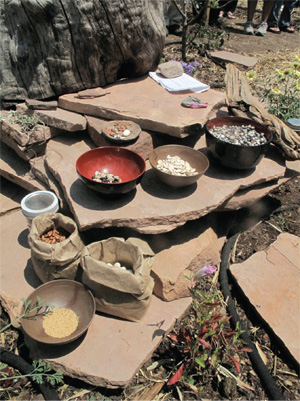 Just inland from the Pacific coast of Northern California, I stand hip-deep in the surge of summer. Padron peppers ripen, lime green and veridian, alongside plump opal eggplants overhung with the heat-bloated vines of Sun Gold tomatoes. Fat honeybees heavy with amber sunflower pollen shuttle through the slow loom of August. In this throb of fecundity, I long for the lean pulse of the arid Southwest.
Just inland from the Pacific coast of Northern California, I stand hip-deep in the surge of summer. Padron peppers ripen, lime green and veridian, alongside plump opal eggplants overhung with the heat-bloated vines of Sun Gold tomatoes. Fat honeybees heavy with amber sunflower pollen shuttle through the slow loom of August. In this throb of fecundity, I long for the lean pulse of the arid Southwest.
In June of this year I traveled to Upaya Zen Center in Santa Fe to help establish a 30’ x 40’ vegetable garden. At 7,200 feet in the Sangre de Cristo mountains, the air was dry as bleached bone. No rain for 113 days; dark-blood and ash-gray skies acrid with smoke from wild land fires. I stood on the barren spine of the garden site with 25 Zen practitioners, neighbors, and friends, every moist molecule of ocean fog wicked out of me, plotting paradise at the fiery rim of the known gardening world.
Great doubt arose in full Zen plumage, with curved talons and a razor beak. Every garden is a contrivance, stamped with inherent contradiction and strangeness. If, as Heraclitus proclaims, the dry mind is best, why tinker with southwestern soil in times of severe climate crisis? Earthquake, tsunami, and nuclear disaster in Japan; volcanic spew reshaping Hawaii; massive flooding of the Missouri and Mississippi rivers; and the tread of tornado, cyclone, and twister from Tuscaloosa to Joplin mark these times. Still, here we stood, a gaggle of well-fed Zen folks presuming to garden the high desert, cultivated for centuries by adept and frugal Native American farmers.
Fortunately, Upaya’s grounded neighbors, endowed with generations of local knowledge, rescued us from the grip of existential dilemma. In silence they turned us to face the circle of sacred mountains surrounding our rough garden site: the tall Truchas Peaks to the east, the Sandia Mountains in the south, the Chicoma Mountain to the west, and the Canjilon Mountain of true north. “Remember where we’re standing,” they admonished us, “and who the original farmers of this place are. Now, let’s make a fence, dig some holes, get a bunch of local, drought-hardy Three Sister vegetable seed, splash on some water, and chant Dogen all night long. Then we’ll have a decent garden.”
And so we got to work, laboring for two days solid, etching paradise on unmarked ground. Cool-tined digging forks entered the dry dust of Upaya soil and emerged, burning. A stout six-foottall wood and woven-wire fence was raised, evoking the Avestan word pairadaeza for walled enclosure. Our modern southwestern paradise followed the ancient foursquare design woven into Persian rugs for centuries and found in Egyptian wall paintings more than 4,000 years old. In the center of the garden we dug a circular wildflower haven with an elegant Kuanyin figure inhabiting the core. Close by, the Zen windmill for pumping well water clacked and spun, a giant prayer wheel turning red, smoky air.
 By nightfall of our last day of working together, the garden was formed, all four quadrants planted to the ancient trio of corn, beans, and squash. Thick rows of Navaho blue corn from nearby Española were sown alongside twenty raised mounds of assorted indigenous winter squash. Two sections of fence line were planted for Rattlesnake beans, Aztec White pole beans, and Scarlet Runners collected from a legendary local gardener. Handmade prayer flags with blessings for the garden festooned the fence line of our newly enclosed paradise.
By nightfall of our last day of working together, the garden was formed, all four quadrants planted to the ancient trio of corn, beans, and squash. Thick rows of Navaho blue corn from nearby Española were sown alongside twenty raised mounds of assorted indigenous winter squash. Two sections of fence line were planted for Rattlesnake beans, Aztec White pole beans, and Scarlet Runners collected from a legendary local gardener. Handmade prayer flags with blessings for the garden festooned the fence line of our newly enclosed paradise.
On our final morning together, friends and neighbors joined us to dedicate the garden. We offered incense and chanted while local kids scattered flower petals and fragrant herbs and sowed a long line of Hope Dye sunflowers. At the eastern entrance to the garden, Maryam Amiryani, an artist living in Marfa, Texas, who had participated in the whole gardening retreat, stepped forward to speak. Maryam grew up in an unusual 17th-century garden in Tehran, an enclosed paradise designed in the classic Islamic style and tended by a former French priest. After the revolution her home was taken and converted first to a hospital, then to a seminary, and then to headquarters for the archives of the Islamic government. “This Upaya garden has given something back to me that I had lost for 34 years, “ Maryam whispered, hanging a small prayer flag inscribed with flowing Persian script at the garden gate.
Now in full August this Zen garden is thriving, alive with spare yet muscular fertility. The dry mind of paradise drops down deep roots. Imagining 2,000-yearold native blue corn ripening in the Sangre de Cristo Mountains, I remember an old Zen admonition:
Practice with infinite gratitude to
the past,
Infinite service to the present,
And infinite responsibility to the
future.
Thank you for subscribing to Tricycle! As a nonprofit, we depend on readers like you to keep Buddhist teachings and practices widely available.